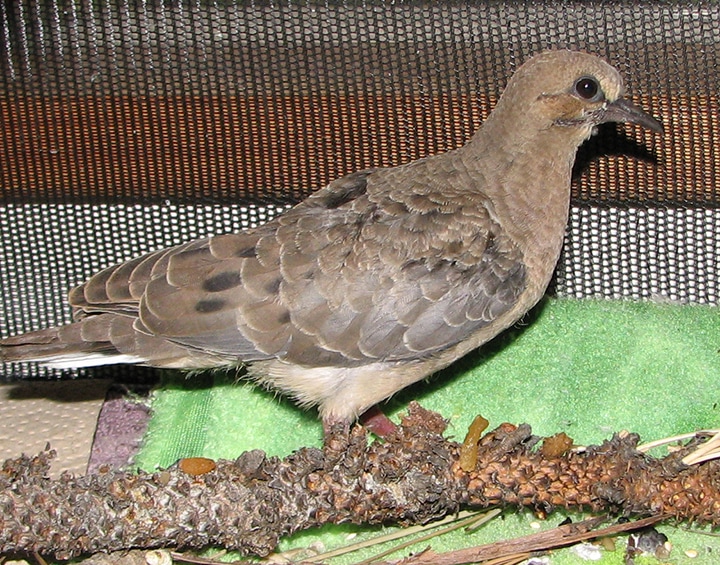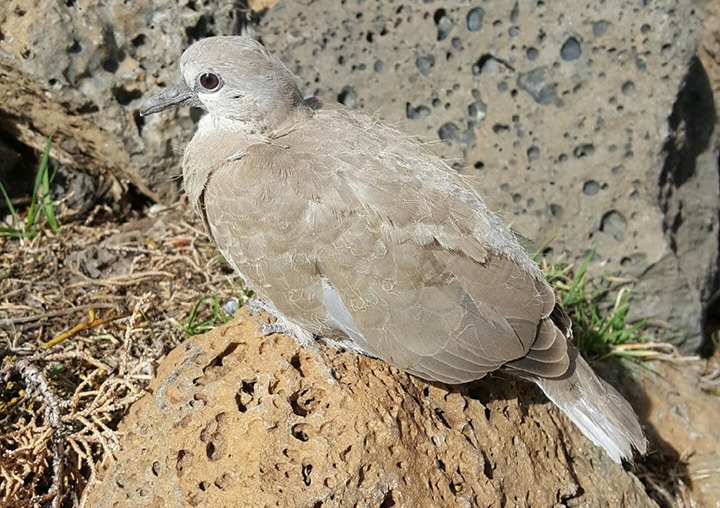|
We know its a dove, because she has that dove 'look' - heavy bodies, smallish head, not a full upright position (like a robin), long tail. Now, what kind of dove? What are the distinguishing characteristics? Bird ID is not easy, but its fun. Generally, you look for several things. First, basic appearance...what does it look sorta like (a canary? a regular yard bird? a duck?). Then you look at color, size, head size, tail length, type of bill (length and color too), feet, markings on the feathers, where it is. After that, more detail is needed. Try to use a common bird, like the robin or mallard as your comparison to gauge size. How about the next bird? Yep, another dove. And, both are fledglings. What differences do you see? If you saw them side by side, you would see that the one below is about half the size of the other. In fact, you could say the one below is small, and the one above is medium sized. Also, they both are smaller than the adults, and look young. The Collared above does not have its black feathers around the neck that look like a collar. The dove below is a darker color than its parents; the dove above is lighter than its parents. Fledges can be hard to ID, but you can get a sense of if it sorta looks young. Also, fledges often cannot fly yet. They can leave the nest early (totally normal) and stay on the ground for up to a week unable to fly. Now, look at the bills. The top one has a heavy, light grey bill, it has bumps on it, and its longer. The one below has a shorter, smaller, brown bill, more pointed. Overall color is different too. Light cocoa below with black spots; color of a hamburger bun mixed with grey above. The bird below is darker, smaller, with spots, and a small, but pointed brown bill. The one above, is a roundish, heavy looking bird, with light almond (hamburger bun) with grey in it, and a heavyish, long, grey bill.  Now, what are they? The one below is our native Mourning Dove. The one above is the Eurasion Collared Dove, they are not original to the US and in fact are having an ecological impact on the smaller mourning dove. They both eat food on the ground: insects, seeds, vegetation. Both nest in trees. The Collared Doves are bigger birds and aggressive to the mourning doves as they compete for valuable food and nesting sites. Help I Found a Fledgling! That's great! Now, before you pick her up, check the scene out. Is she injured, or just bebopping around eating or resting in the sun? Look for the parents. Are there others around? Did you see something capture it, a cat or dog? Is it safe more or less? Are their immediate dangers to the bird that nothing can be done about (like someone else's outdoor cat? Can you ask that person to put the cat inside for a few days? Is it near a window? Has it been in the same place for a long time (sitting still for an hour for example, stunned at the base of a house under a window?
Ground feeding birds are best left to learn how to eat and find food. The ground is their dinner table. As young birds, they need to learn to find food. The parents are teaching them by showing them where the food is and bringing them some. And the young are learning on their own. In general, we tend to leave the bigger, more robust Collared Doves alone. The Mourning Doves we can talk to you about to gauge whether there is a real need for 'rescuing'. We can never replace these birds' wild foods in rehab, so we are careful about rushing them in to care. Like all of our youth, they should be watched over some and their play/feeding grounds made as safe as possible for them. Make sure they have some water, and you are not bothering or scaring them if they are in your yard. Bring the dog or cat in till they can fly. If you are really concerned, the bird is just not flying off, there are no parents (and you have given them privacy to return), and they look injured. Call us. In the meantime, enjoy your doves. They are a neat and pretty bird. The Mourning Doves are a sweet, gentle, and fun little bird. |
AboutNative Bird Care's is celebrating its 10th anniversary! Our main focus is song, shore, and waterbirds. We offer specialized care and facilities for these extraordinary birds.. Archives
January 2024
Categories
|

 RSS Feed
RSS Feed